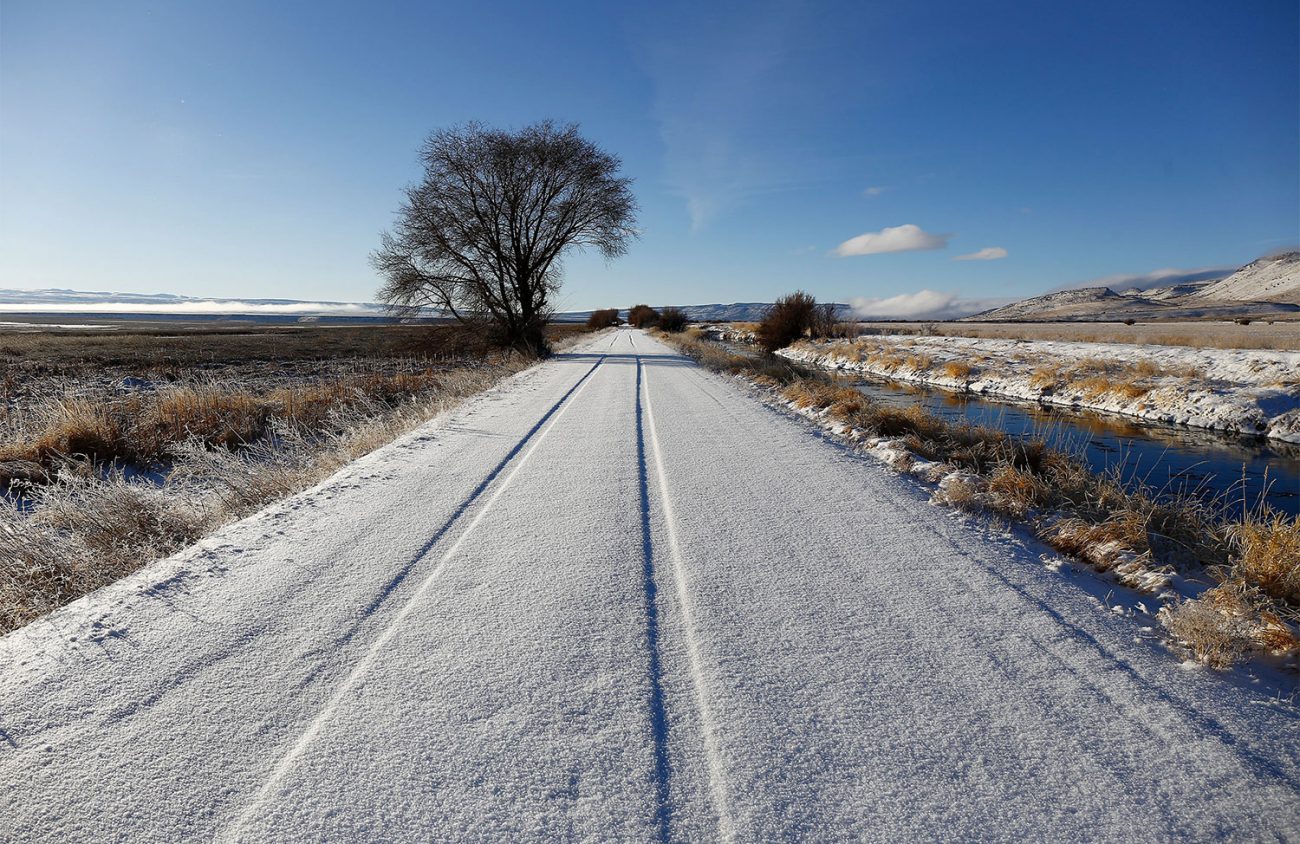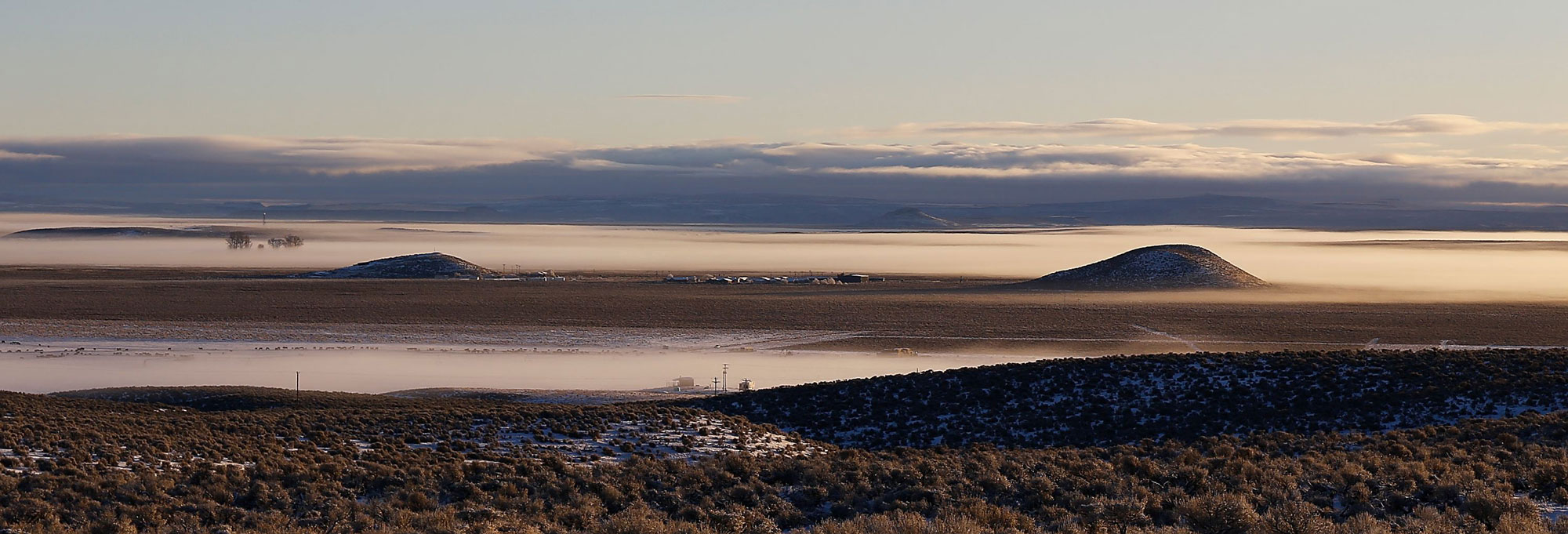Most people visit Malheur National Wildlife Refuge in the spring. That’s when birds, migrating north along the Pacific Flyway, turn up by the thousands at the famous eastern Oregon refuge, which encompasses high desert marshland in remote Harney County 30 miles south of Burns. In May the weather is generally close to comfortable, so long as you don’t mind hordes of mosquitoes, and on Memorial Day weekend hundreds of birders traditionally pack the refuge and nearby motels and campgrounds to sort through the migrating flocks for rarities.
For the past two decades, though, my son and I have also taken up visiting Malheur in the depths of winter. It’s a time of splendid quiet, spectacular isolation — and, at times, bitter cold.
No matter what the season, we usually stay at Malheur Field Station, a delightfully odd semi-resort that sits on refuge land.
At first glance, the field station, in open desert about two miles west of the refuge’s stately Civilian Conservation Corps-built headquarters, looks like a secret government facility from the 1950s nestled in the sagebrush between two low buttes. A sprawling campus of perhaps two dozen buildings, many now in various degrees of disrepair, it was constructed in 1965 as a Job Corps youth camp before it lost its funding and closed in 1969.
Rescued and renamed Malheur Field Station by a group of Northwest colleges and universities to operate as a science outpost, MFS has been run since 1987 by an educational nonprofit, The Great Basin Society, which owns the buildings — including dormitories, a functional dining hall with kitchen, a gymnasium and wood and automobile shops — and currently holds a 25-year lease on the 320-acre site from the U.S. Fish and Wildlife Service.
Enough history. What matters for travelers is, the field station rents out rooms, apartments and even entire houses right on the refuge at very modest rates. Pandemic restrictions aside, the station currently has beds for 152 guests; perhaps another 50 are in old dormitories that need renovation before anyone can live in them again.
When my son and I stayed at MFS for a week at the end of January, we were the only guests at the entire compound.
We booked what amounts to a small apartment in the building called Owl, which apparently used to house the infirmary for the youth camp. It still offers a few old-fashioned hospital beds, with cranks at the foot that work. Though the field station normally rents individual bedrooms in Owl, meaning you might share your living room and kitchen with strangers, during the pandemic only one party is booked into any unit.
Besides its three small bedrooms, Owl East offers a comfortable living room, furnished with sofa, loveseat and easy chair, as well as a kitchen/dining area, complete with pots, pans and utensils, and a utilitarian bathroom with shower. A battleship gray government desk sits next to the dining table, should you feel the need to do office work, and bookshelves are stocked with nature guides, airport mysteries and poetry magazines.
The winter rate for Owl East was $80 a night, with a seventh night free after the first six.
Any time of year, the attractions of the refuge are subtle. Many people come expecting that because Malheur is a famous wildlife refuge, they will be entertained here by charismatic, easy-to-spot, Disney-style birds and animals. This is never the case.
The best way to find wildlife and enjoy the refuge is to drive the 30-mile gravel road called the CPR, for Center Patrol Road; from the refuge headquarters it follows the Blitzen River south through open marsh land, sometimes interrupted by roadside stands of willows that harbor flickers, hawks, owls and songbirds, depending on the season. Cruising along at 10 mph you also see deer, coyotes, porcupines and the occasional antelope or badger, sometimes close enough to photograph. The big challenge is to make sure you don’t get so distracted watching for animals while driving that you veer into the river before you emerge on a paved road again near the tiny town of Frenchglen.
When we headed out the third morning of our recent trip, the car thermometer measured 3 below zero, Fahrenheit. The world around us was stark and frozen, with swirling fog turning the sunrise into a subtle light show in the east. The previous day’s four inches of snow was untracked by cars, meaning we had the entire refuge to ourselves; it felt like a scene from Dr. Zhivago. As beautiful as it all was, the cold weather and isolation inspired a few extra precautions, like carrying sleeping bags, food and water each time we drove the CPR. Car trouble could mean a long cold wait for help.
Birding is slow but interesting in the winter chill. Gone are the bright warblers of spring; in return you get good close-up looks at owls and other raptors, which are reluctant to expend the energy required to fly away if they don’t absolutely have to.
The field station is under new management. A Louisiana native who’s lived in eastern Oregon for decades, Rose Garacci took on the job of running the field station three years ago and has been working ever since to upgrade old buildings that resemble a desert ghost town.
A rugged, practical woman who had worked as a bank teller and a legal secretary and as a volunteer for various nonprofits, she jumped at the chance when the manager’s job came open. “The job was on the west side of Steens Mountain, and I own property on the east side,” she says. “It was a perfect fit.”
The job has not been without its surprises. Early on Garacci was cleaning the entryway to Malcolm Hall, the main office building, and found an unnoticed door hidden behind a magazine rack. Behind it was a complete chemistry lab with “a whole bunch of weird equipment,” she says, apparently untouched for half a century. “I got a real big kick out of that one. It was like walking into a time capsule.” She also found a similarly unnoticed photographic darkroom.
In 2018, within weeks after she started work, a wind storm knocked down a station power pole. The repair crew snagged a water pipe with their backhoe, and the resulting shock to the field station’s antiquated water system caused a series of underground leaks to bubble up throughout the facility.
The repair came to $200,000, a figure that seemed catastrophic, but Garacci rounded up donors who covered the bill with cash or, in one case, a substantial no-interest loan, and the water was soon switched back on.
Now she’s looking ahead to improving the physical facility. Garacci hired a maintenance manager; the two of them are painting unpainted walls — they found a lot of paint in one of the shop buildings — sprucing up the interiors of dorms, apartments and houses, mowing out-of-control brush around the main office and in a long-disused children’s playground. She’s hired a chef to re-open the cafeteria this spring with take-out food. She’s brought in a water filtering system so each housing unit can have palatable bottled water (what comes out of the station’s taps has a strong mineral flavor). She’s updated the station’s website. She’s looking at grant money that could allow her to re-open even more bedrooms in the station so it could serve as an evacuation shelter when the catastrophic Cascadia subduction zone quake finally strikes Oregon. And she’s already started replacing the field station’s series of ramshackle residential trailers with small cabins to rent out.
More deeply, Garacci also wants to expand on the field station’s long-time educational mission. “We’d like to see more children here,” she says. “We’d like to offer an outdoor school. Some kids in Portland can barely leave their apartment complexes. And I’d like to see them come here to the desert.”
Malheur Field Station, 34848 Sodhouse Lane, Princeton, is more akin to a hostel than a hotel. Rooms, trailers and houses don’t lock. Theft is a non-issue, though if you’re worried about particular valuables you might lock them in your car. Bring your own bed linens and towels, and make your own bed, as there’s no daily housekeeping. Guests are expected to do a basic cleaning before they leave, including sweeping the floors, wiping surfaces and emptying the trash.
Advance reservations with a 50 percent deposit are required. Make them at MalheurFieldStation.org, or call 541-493-2629.

